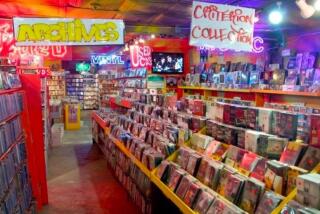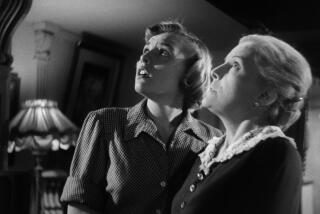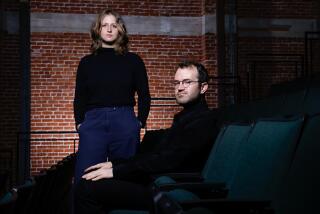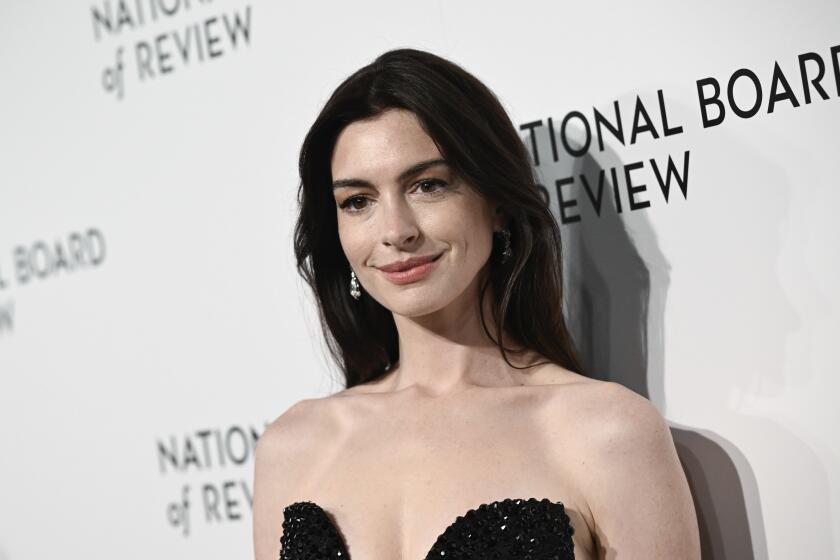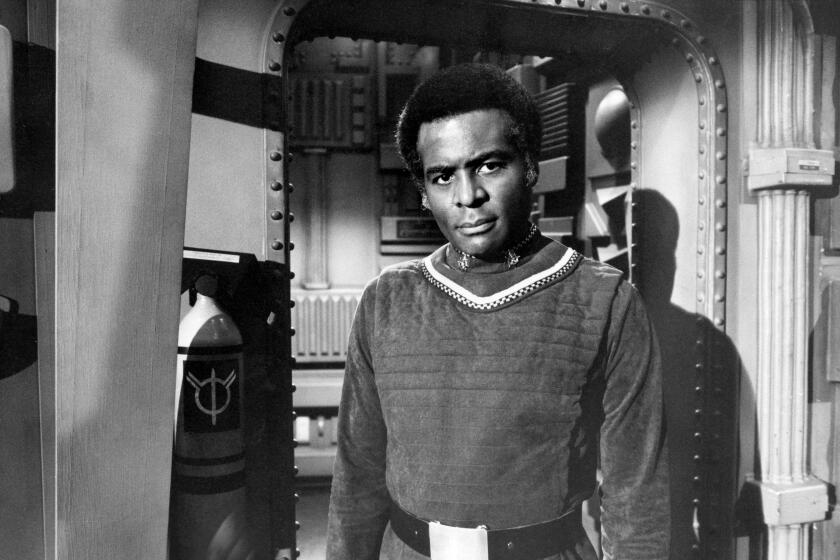UCLA archive prepares to show off some of its ‘Treasures’
I’ve always loved the smell of preservation in the morning, but this year more so than ever.
The UCLA Film & Television Archive’s biennial Festival of Preservation, a chance for the largest university archive of motion pictures and TV programming to showcase the unforgettable cinema it has brought back to visual life, has always been the Los Angeles film event I look forward to most.
This year, however, as part of the archive’s 50th-anniversary celebration, UCLA is doing something different. In an 11-week program titled “Archive Treasures,” it is in effect showing off, presenting its greatest hits, which include some of the most significant and popular restorations it has ever done.
SIGN UP for the free Indie Focus movies newsletter >>
It is, as the program notes proclaim, “a gift from the Archive’s family to audiences,” and it begins Oct. 2 with a drop-dead gorgeous print of the Michael Powell-Emeric Pressburger ballet extravaganza “The Red Shoes.”
If you are a movie fan, the idea of seeing a whole range of motion pictures in as close to pristine condition as modern technology can provide is the keenest of thrills. Viewing vintage films the way they were supposed to be seen, without scratches, fading or discoloration, is a revelation.
To experience how crisp and bright a print can be, to understand how much subtlety of shading and tone can go into black and white, how much unimaginable richness color can provide, is to bemoan the sad state most of our movie heritage has fallen into.
The regrettable truth is that fully half of the 21,000 feature-length movies produced in this country before 1951, including 90% of all silent films, have been lost, destroyed or deteriorated beyond recognition.
Because UCLA is a leader in restoration and preservation (an elaborate business that requires delicate technical skills and painstaking detective work), events like Archive Treasures give the wider public a chance to see what the fuss is all about.
Like the regularly scheduled preservation festivals, the current program divides its time between widely admired classics and little-known riches from cinema’s attic, feature rarities and overlooked short items (an “Intimate Interview” with Bela Lugosi, a snappy performance by the 20-member all female jazz band the Ingenues) that fill gaps in film history you didn’t even know existed.
Two of the more unusual features this time were both shot in the strange, ethereal and quite lovely early process known as two-strip (as opposed to the later three-strip) Technicolor.
The earliest of these, 1930’s “Follow Thru,” a story of golf and love, reproduces the musical numbers of one of the hit Broadway shows of the 1920s. Not to be missed is the irrepressible Zelma O’Neal (critic Brooks Atkinson called her “a merry brat”) dancing with devils in the bouncy “I Want to Be Bad.”
Coming five years later was one of the last films produced in that two-strip process, the one-of-a-kind “Legong: Dance of the Virgins,” characterized by UCLA as a “narrativized travelogue,” which is as good a description as any.
A silent film set in picturesque Bali and characterized by exotica like fighting roosters and topless temple maidens, its story of what happens when a sacred dancer falls in love with the wrong guy was directed by Henri de la Falaise, a French marquis and war hero who somehow ended up in Hollywood married to star Constance Bennett.
Because this is a series weighted toward favorites, I have decided to limit my obsession with obscurities and instead spend quality time luxuriating in immaculate copies of classics I can’t see often enough, movies whose print condition allows me to imagine I am experiencing these films just as the original audiences had back in the day. What could be better than that?
When you are talking visual splendor, you can’t improve on the great Max Ophüls, the master of the moving camera. Best known for his European masterworks like “The Earrings of Madame De ...,” Ophüls worked briefly in Hollywood, never to better effect than in 1948’s “Letter From an Unknown Woman.”
A story of the ultimate in unrequited love, it stars Louis Jourdan as a great romantic pianist and practiced seducer and Joan Fontaine as a woman who devotes her life to him without his ever suspecting. Camera movement was like breathing to Ophüls; he delighted in efforts so subtle that you almost don’t realize they’re happening. “Letter” is also an example of black-and-white Hollywood visual craftsmanship at its best.
A very different use of black and white is shown in Stanley Kubrick’s searing 1957 World War I drama “Paths of Glory.” Starring Kirk Douglas in one of his most dynamic performances as a French officer horrified by the waste of human life, it is so unapologetic about the callousness of France’s military high command that it was banned in that country for 18 years.
But in UCLA’s splendid restoration (largely from cinematographer George Krause’s original camera negative), the film’s visual qualities, its dark blacks and dazzling whites, sparkle as much as the drama. At 6 feet wide, the trenches built for filming were 2 feet wider than the WWI originals, but they allowed for bravura tracking shots that even Ophüls would have envied.
When it comes to color cinematography, Jack Cardiff was one of the masters of the form, and he expertly used it to create mood in 1954’s “The Barefoot Contessa.” The film stars Humphrey Bogart as a seen-it-all director and Ava Gardner in one of her signature roles as Maria Vargas, a woman beautiful enough “to use the moon for a key light.”
Few people were better suited to telling the story of what happened when Maria Vargas went from obscurity to Hollywood stardom than supremely literate writer-director Joseph L. Mankiewicz. When you hear lines like “life every now and then behaves as if it’s seen too many bad movies,” you know you’re in the right place.
Monument Valley was the right place for director John Ford. He made numerous films there, but the John Wayne-starring “She Wore a Yellow Ribbon,” the middle picture in his cavalry trilogy, was the first time Ford shot there in color.
Even today, “Yellow Ribbon’s” compositions are compelling, never more so than in the scene of a troop of cavalry riding into a visually spectacular storm. Cinematographer Winton Hoch shot the storm under protest and ended up with an Oscar for his trouble.
For me, “She Wore a Yellow Ribbon” has a more personal connection to the UCLA archive. On the 2006 retirement of Robert Gitt, the archive’s legendary preservation officer and the man responsible for numerous unforgettable restorations, a tribute to him included a clip from that film showing Wayne’s character leaving the cavalry and getting a pocket watch inscribed “Lest We Forget.” Then, in a wonderful film-meets-reality moment, Gitt was presented just such a watch. Lest we forget, indeed.
UCLA Festival of Preservation
Where: Billy Wilder Theater, Hammer Museum, 10899 Wilshire, Westwood.
When: Oct. 2 through Dec. 19; screenings at 7:30 p.m. unless otherwise noted.
For more information www.cinema.ucla.edu or (310) 206-8013.
Schedule
Oct. 2: “The Red Shoes”
Oct. 3: “Gilda,” “The Bigamist”
Oct. 4 at 7 p.m. “His Girl Friday,” “The Awful Truth”
Oct. 16: “The Night of the Hunter,” “Macbeth”
Oct. 19: “My Darling Clementine,” “She Wore A Yellow Ribbon”
Oct. 31: “Intimate Interviews: Bela Lugosi,” “The Bat Whispers”
Nov. 1 at 7 p.m. “The Ingenues,” “Follow Thru,” “Becky Sharp”
Nov. 7: “Paths of Glory”
Nov. 14: “The Barefoot Contessa,” “Letter From An Unknown Woman”
Nov. 22 at 3 p.m. “Tabu: A Story of the South Seas,” “Legong: Dance of the Virgins”
Nov. 30: “A Face In The Crowd,” “The Naked Kiss”
Dec. 5 at 3 p.m. “Tillie’s Punctured Romance,” “Safety Last”
Dec. 6 at 7 p.m. “Wanda,” “Shadows”
Dec. 11: “Bless Their Little Hearts,” “Please Don’t Bury Me Alive”
Dec. 12: “The Big Sleep,” “Double Indemnity”
Dec. 18: “Chicago,” “Applause”
Dec. 19: “Blonde Venus,” “The Love Parade”
MORE:
More to Read
Only good movies
Get the Indie Focus newsletter, Mark Olsen's weekly guide to the world of cinema.
You may occasionally receive promotional content from the Los Angeles Times.
